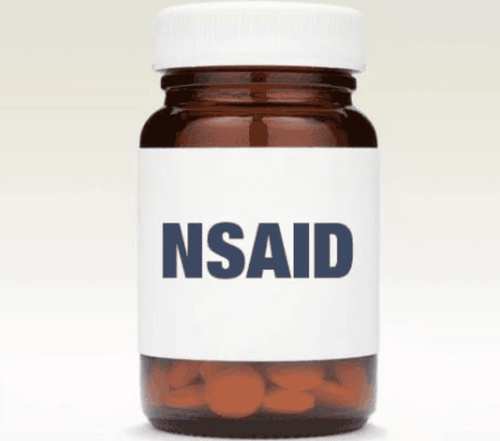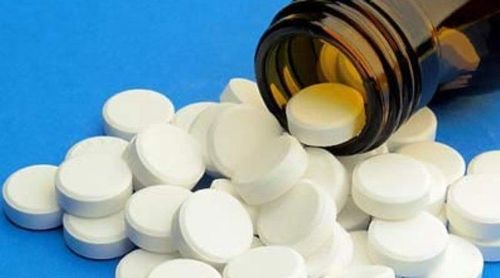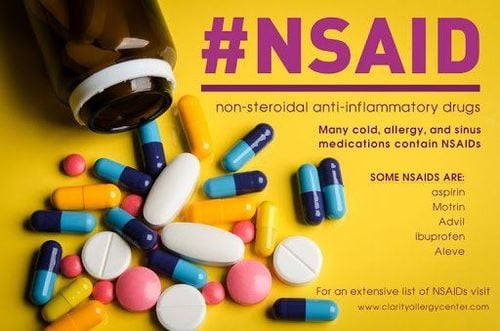This is an automatically translated article.
Keflafen 75 is a medicine containing the main active ingredient, Ketoprofen, which is a member of the group of non-steroidal anti-inflammatory drugs (NSAIDs), which can be used without a prescription.1. What is Keflafen 75?
Keflafen 75 is one of the products of Ha Tay Pharmaceutical Joint Stock Company, which is prepared in the form of capsules with 2 different strengths: Ketoprofen 50 mg and Ketoprofen 75 mg (or Keflafen 75). Ketoprofen is a non-steroidal anti-inflammatory drug of the propionic group, a derivative of aryl carboxylic acid with analgesic, antipyretic, and anti-inflammatory effects. However, the antipyretic effect of ketoprofen is poor, so Keflafen 75 is rarely used as an antipyretic alone. The anti-inflammatory mechanism of ketoprofen non-selectively inhibits the enzyme cyclooxygenase (COX) - the enzyme that synthesizes a chemical mediator of inflammation called prostaglandins, thereby reducing the inflammatory process. Keflafen 75 also inhibits leukocyte chemotaxis, inhibits the migration of leukocytes to the inflammatory site, antagonizes the proteolytic enzyme system, prevents protein transformation, stabilizes the lysosomal membrane, and antagonizes the protein-degrading enzyme system. the effect of chemical mediators such as serotonin, histamine...
Ketoprofen for pain relief from mild to moderate, the location of action at peripheral sensory receptors, good effect on pain caused by inflammation. The mechanism of pain relief is to reduce the synthesis of prostaglandin E2, thereby reducing the sensitivity at the nerve endings to the pain agents of the inflammatory response such as bradykinin, serotonin...
Ketoprofen is the active ingredient that works. Non-selective cyclooxygenase inhibitor (inhibits both COX-1, COX-2):
COX-2 inhibitor: anti-inflammatory, analgesic and antipyretic; COX-1 inhibitors: cause side effects on gastrointestinal, renal, bleeding time (reducing thromboxane A2 synthesis in platelets, inhibiting platelet aggregation, prolonging bleeding time).
2. Uses of Keflafen 75
Keflafen 75 is indicated for use in the following diseases:
Rheumatoid arthritis; Osteoarthritis ; Ankylosing spondylitis ; Acute joint and periarticular disorders (bursitis, bursitis, synovitis, tendinitis); Degeneration of the cervical spine; Low back pain (muscle strain, low back pain, sciatica, fibromyalgia); Musculoskeletal pain; Gout level; Pain and inflammation control after orthopedic surgery.
3. Dosage and how to use Keflafen 75
How to take Keflafen 75: Keflafen 75 is taken orally, patients should take ketoprofen with food or drink with a full glass of water, avoid taking with alcoholic beverages to minimize harmful effects for the gastrointestinal tract of the drug Keflafen 75 . In the case of patients with gastric pain who are prescribed Keflafen 75, it is recommended to use additional gastric mucosal drugs, currently no reduction in the absorption of Ketoprofen when co-administered with aluminum gel has been observed.
Dosage of Keflafen 75 in the symptomatic treatment of inflammation in adults: symptomatic treatment of acute or chronic rheumatoid arthritis, osteoarthritis or musculoskeletal disease: Keflafen 75 dose 75 mg (l tablet)/time , used 3 times / day, can increase the dose of Keflafen 75 to 300 mg (4 tablets) / day, divided into 2 times. Dosage of Keflafen 75 in the treatment of pain in adults: 75mg (1 tablet) / time, 2 times / day. Dosage of Keflafen 75 for patients with renal or hepatic impairment: reduce the dose by 33-50% of the usual dose. The maximum dose of the active ingredient ketoprofen for mild renal impairment is 150 mg (2 tablets)/day and moderate renal impairment is 75 mg (1 Keflafen 75 tablet)/day. Patients with hepatic impairment with serum albumin levels less than 3.5 g/dl should receive an initial dose of keflafen 75 of 75 mg (1 tablet)/day.
4. Contraindications of Keflafen 75
Keflafen 75 is contraindicated in the following cases:
Patients with hypersensitivity to the active ingredient Ketoprofen, Aspirin or non-steroidal anti-inflammatory pain relievers or any of the ingredients of Keflafen 75. In active gastric and duodenal ulcer, Keflafen 75 is contraindicated in children under 18 years of age. Patients with bronchospasm, asthma, severe rhinitis; People with angioedema or urticaria caused by Aspirin or another non-steroidal anti-inflammatory drug; Patients with severe liver failure; Patients with severe heart failure; Severe renal failure, glomerular filtration rate < 30 ml/min; The patient has a history of bleeding, ulceration, gastrointestinal perforation, and internal bleeding.
5. Be careful when using Keflafen 75
Choose the lowest effective dose of Keflafen 75 with the shortest duration to control symptoms, avoid using ketoprofen with other NSAIDs. The dose of Keflafen 75 should be reduced in the elderly. Patients with heart disease, kidney disease, liver failure, aortic stenosis should carefully monitor renal function when starting treatment with Keflafen 75 ; Use of Keflafen 75 in patients with a history of hypertension may cause fluid retention and edema; Beware of the risk of symptomatic hypotension, angina pectoris, and myocardial infarction when starting and increasing the dose of Keflafen 75. Patients with asthma, chronic rhinitis, chronic sinusitis, nasal polyps can lead to asthma attacks or bronchospasm when taking Keflafen 75. For patients with a history of peptic ulcer: Keflafen 75 may cause gastrointestinal bleeding, ulceration or perforation of the stomach; Patients with systemic lupus erythematosus: Keflafen 75 will increase the risk of aseptic meningitis; Using Keflafen 75 can cause: skin reactions, visual disturbances, cardiovascular effects, fertility, masking of infection symptoms; Children under 15 years: Safety and effectiveness of Keflafen 75 have not been established, so ketoprofen should not be used in this age group; In case of long-term treatment with Keflafen 75, it is necessary to monitor the blood count, liver function and kidney function; Effects of Keflafen 75 on drivers and operating machines: Patients should be warned about the possibility of drowsiness, dizziness, fatigue, visual disturbances when using Keflafen 75; Using prostaglandin synthesis inhibitors (such as Keflafen 75) in early pregnancy increases the risk of miscarriage and birth defects. In the first 6 months of pregnancy, Keflafen 75 should not be used unless absolutely necessary, then the dose of Keflafen 75 should be low and the duration of treatment with Keflafen 75 should be as short as possible. Ketoprofen is contraindicated in the last 3 months of pregnancy due to the risk of toxicity on the heart, lungs, kidney function in the fetus, Keflafen 75 can inhibit uterine contractions leading to delayed labor, prolong labor. ; Ketoprofen is excreted in human milk in low concentrations, therefore it is not recommended to use Ketoprofen during lactation.
6. Undesirable effects of Keflafen 75
Undesirable effects of Keflafen 75 are very common:
Digestive disorders (11%); Abnormal liver function (15%). Undesirable effects of Keflafen 75 are common:
Fatigue, headache, depression, dizziness, tinnitus, trouble sleeping; Dyspepsia, abdominal distension, epigastric pain, nausea, diarrhea, constipation, renal dysfunction, gastric bleeding, peptic ulcer (>2%), gastritis, anorexia (>1%) ; Renal dysfunction (3–9%); Pruritus, skin rash (> 1%); Peripheral edema (2%); Visual disturbances (> 1%); Irritation of the urinary tract (> 1%). Undesirable effects of Keflafen 75 are uncommon:
Anaphylaxis; Stevens-Johnson syndrome, urticaria, Quincke's edema, photosensitivity, toxic epidermal necrolysis, eczema, erythema multiforme; Hepatitis, jaundice; Asthma, allergic rhinitis, burning sensation in the throat; Interstitial nephritis, renal capillary necrosis; Agranulocytosis, leukopenia, thrombocytopenia hemorrhage, hemolytic anemia, peripheral edema, hyponatremia, hypertension. Undesirable effects of Keflafen 75 are rare:
Hemorrhagic anemia; Anaphylaxis ; Visual disturbances; Asthma, rhinitis; Nephritis, nephrotic syndrome. Undesirable effects of Keflafen 75 are very rare:
Pancreatitis; Bullous skin disease. To limit the undesirable effects of Keflafen 75 or non-steroidal anti-inflammatory drugs in general, patients need to follow the principle: Choose the lowest effective dose of Keflafen 75, the shortest time to take Keflafen 75. and adjust the dose according to individual response. Keflafen 75 should be taken with food, milk, antacids or with a full glass of water, avoiding alcoholic beverages to reduce the effect on the gastrointestinal tract of Keflafen 75.
7. Interactions of Keflafen 75 with other drugs
Anticoagulants (Heparin, Warfarin) and platelet aggregation inhibitors (Clopidogrel), Ticlopidine: may increase the risk of bleeding by inhibiting platelet aggregation and attacking the gastric mucosa by non-steroidal anti-inflammatory drugs, including Keflafen 75. Therefore, when necessary, the combination must be closely monitored clinically and biologically. Concomitant use of Keflafen 75 with other nonsteroidal anti-inflammatory drugs (including salicylates at high doses) increases the risk of gastrointestinal ulceration and bleeding; Use of Keflafen 75 with lithium: causes hyperlithemia, may reach toxic values due to decreased renal excretion of lithium, requires close monitoring of serum lithium and dose adjustment of lithium during and after discontinuation of therapy with the drug. Keflafen 75 . Keflafen 75 increases the hematological toxicity of methotrexate by reducing renal clearance and competing for binding to plasma proteins. When taking Keflafen 75 with Hydrochlorothiazide, it will cause a decrease in the excretion of chloride and potassium leading to renal failure secondary to decreased blood flow to the kidneys, by inhibiting prostaglandin synthesis. Closely monitor the patient, adjust the dose of Keflafen 75 as needed and monitor the water/electrolyte balance. Concomitant use of Keflafen 75 with cardiac glycosides, analgesics, other NSAIDs, corticosteroids, quinolone antibiotics, probenecid, tacrolimus, zidovudine increases the risk of side effects.
Beta-blockers used together with Keflafen 75 will reduce the antihypertensive effect because non-steroidal anti-inflammatory drugs inhibit vasodilator prostaglandins.
8. Keflafen 75 overdose and how to handle it
Similar to other propionic acid derivatives, Ketoprofen is less toxic than aspirin, most symptoms of Keflafen 75 overdose can be:
Somnolence; Abdominal pain and vomiting; Lower blood pressure ; Bronchospasm; Gastrointestinal bleeding; Some cases of acute kidney failure and liver damage. Cases of Keflafen 75 overdose have been reported with doses up to 2.5g of ketoprofen.
Keflafen 75 does not have a specific antidote, usually only symptomatic treatment and support to induce vomiting, gastric lavage, use activated charcoal to reduce the absorption and reabsorption of ketoprofen. Strong diuresis, alkalinization, hemodialysis or blood transfusion cannot be used because ketoprofen is strongly bound to plasma proteins.
In summary, Keflafen 75 is a drug containing the main active ingredient, Ketoprofen, which is a drug belonging to the group of non-steroidal anti-inflammatory drugs (NSAIDs). To ensure effective treatment and avoid unwanted side effects, patients should carefully read the instructions for use or consult a doctor or pharmacist.
Follow Vinmec International General Hospital website to get more health, nutrition and beauty information to protect the health of yourself and your loved ones in your family.
Please dial HOTLINE for more information or register for an appointment HERE. Download MyVinmec app to make appointments faster and to manage your bookings easily.













